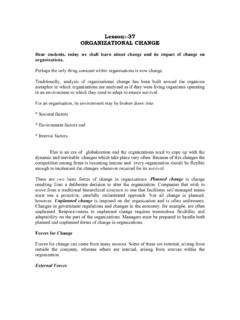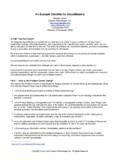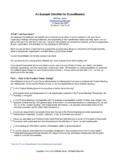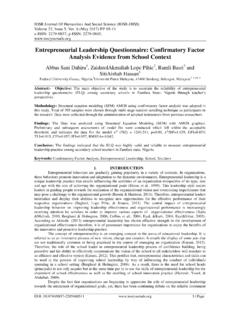Transcription of Glossary of Scrum Terms - CC Pace
1 Agile the name coined for the wider set of ideas that Scrum falls within; the Agile values and principles arecaptured in the Agile ManifestoArchitect there is no architect role on a Scrum team, instead all team members are responsible for emerging the architectureBurndown (see Sprint Burndown, Product Burndown)Backlog Item (see Product Backlog Item)Chicken (arch.) term for anyone not on the team, the term offended some people so is now rarely used, cf. PigDaily Scrum a fifteen-minute daily team meeting to share progress, report impediments and make commitmentsDone also referred to as Done or Done Done , this term is used to describe a product increment that isconsidered releasable; it means that all design, coding, testing and documentation have been completed and theincrement is fully integrated into the systemEmergence the principle that the best designs, and the best ways of working come about over time throughdoing the work, rather than being defined in advance, cf.
2 Empiricism, Self OrganizationEmpiricism the principle of inspect and adapt which allows teams or individuals to try something out and learn from the experience by conscious reflection and change, cf. Emergence, Self OrganizationEpic a very large user story that is eventually broken down into smaller stories; epics are often used asplaceholders for new ideas that have not been thought out fully. There s nothing wrong with having an epic, aslong as it is not high priorityEstimation the process of agreeing on a size measurement for the stories in a product backlog. Done by the team, usually using Planning PokerFibonacci Sequence the sequence of numbers where the next number is derived by adding together theprevious two; the sequence has the quality of each interval getting larger as the numbers increase; the sequence is often used for Story Points, simply because estimates are always less accurate when dealing with epicsHow the How is a term used to describe the domain of the team, as distinct for the product owner, cf.
3 Also be described as tactic ( how to win the battle)CC Pace 4100 Monument Corner Drive, Ste. 400 Fairfax, VA 22030 fax anything that prevents the team from meeting their potential ( chairs are uncomfortable). If organizational, it is the Scrum Master s responsibility to eliminate it. If it is internal to the team, then they themselves should do away with itImpediment Backlog a visible list of impediments in a priority order according to how seriously they are blocking the team from productivityPig (arch.) term for a team member, the term offended some people so is now rarely used, cf. ChickenPlanning see Sprint PlanningPlanning Poker a game used to apply estimates to stories; it uses the Delphi method of arriving at consensusProcess simply the way someone works.
4 Everyone has a process. It can be pre-defined, empiric or merely Backlog a prioritized list of stories that are waiting to be worked onProduct Backlog Item any item that is one the backlog list, which will include user stories, epics and possibly technical stories to deal with technical debt, Owner person whom holds the vision for the product and is responsible for maintaining, prioritizing and updating the product backlogRelease Burndown Chart a visible chart to show progress towards a releaseRetrospective a session where the Team and Scrum Master reflect on the process and make commitments to improveRoman Vote see Thumb VoteScrum Master a servant leader to the team, responsible for removing impediments and making sure the process runs smoothly so the team can be as productive as possibleScrum Meetings Story Time, Planning, Review, Retrospective, Daily ScrumScrum Roles there are only three: product owner, Scrum Master, team Glossary of Scrum Terms Glossary of Scrum Terms - continued CC Pace 4100 Monument Corner Drive, Ste.
5 400 Fairfax, VA 22030 fax Organization the principle that those closest to the work best know how to do the work, so set clear goalsand boundaries and let them make all tactical and implementation decisions, cf. Emergence, EmpiricismSpike a short, time-boxed piece of research, usually technical, on a single story that is intended to provide justenough information that the team can estimate the size of the storySprint a time boxed iterationSprint Burndown a visible chart that indicates on a daily basis the amount of work remaining in the sprintSprint Goal aka Sprint Theme, the key focus of the work for a single sprintSprint Planning a meeting between the Team and the Product Owner to plan the sprint and arrive at anagreement on the commitmentSprint Task a single small item of work that helps one particular story reach completionStakeholder anyone external to the team with an interest in the product being developedStory a backlog item usually using the template form: as a [user] I want [function] so that [business value], cfProduct Backlog ItemStory Point a unit of measurement applied to the size of a story, cf.
6 Fibonacci SequenceStory Time the regular work session where items on the backlog are discussed, refined and estimated and thebacklog is trimmed and prioritizedTask see Sprint TaskTask List the tasks needed to complete the set of stories committed to a sprintTaskboard a wall chart with cards and sticky notes that represent all the work of a team in a given sprint; thetask notes are moved across the board to show progressTeam the development team, responsible committing to work, delivering and driving the product forward from a tactical perspectiveTeam Member any member of the team, including developers, testers, designers, writers, graphic artists, database Vote a quick pulse to get a sense of where the team are in Terms of commitment, or agreement on a decision, etc.
7 Thumb up generally means agree, yes, or good, and thumb down disagree, no or bad; the analog version of this allows the thumb to be anywhere on the half circle to indicate differing degrees of agreeabilityTimeboxing setting a duration for every activity and having it last exactly that ( neither meetings nor sprint are ever lenghtened - ever)Velocity the rate at which a team completes work, usually measured in story Statement a high-level description of a product which includes who it is for, why it is necessary and whatdifferentiates it from similar productsWhat the What is a term used to describe the domain of the product owner, as distinct for the team, cf. How. Can also be described as strategy ( what s the best order for battles)XP Practices the set of development practices, including pair-programming, test-first, or test-driven development (TDD) and continuous refactoring, which are drawn from the XP methodology; many Scrum teams find these practices greatly improve productivity and team moral








